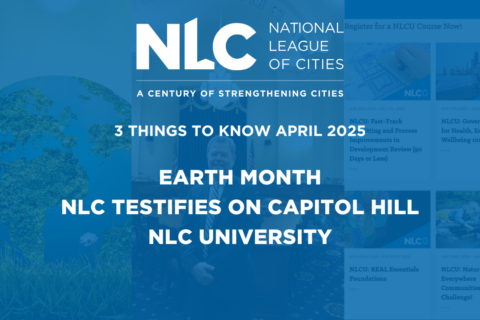For over a decade, local leaders have worked in partnership with the U.S. Environmental Protection Agency (EPA) to develop frameworks that provide the flexibility local governments need to continue progress toward improving our nation’s waterways. These efforts focused on prioritizing the investment of limited dollars to address the most pressing health and welfare issues first and resulted in several successes to benefit communities. While there have been many successes over the years, new guidance from EPA falls short.
What Is Financial Capability?
With local water and sewer rates and stormwater fees rapidly becoming unaffordable for many fixed- and low-income citizens, there is a disproportionate financial burden on these vulnerable populations who live at or below the poverty level. This has been compounded by and made even more evident in the wake of the coronavirus pandemic.
That is why NLC and local leaders have been calling on EPA to work with local governments to revise the “Combined Sewer Overflows—Guidance for Financial Capability Assessment and Schedule Development” (Feb. 1997) to eliminate reliance on Median Household Income (MHI) as the critical metric for determining investment level when it comes to consent decrees and meeting requirements under the Clean Water Act (CWA). It has been shown that this reliance often places a particularly high burden on residents at the lower end of the economic scale.
The FY16 appropriations bill required EPA to contract with the National Academy of Public Administration to conduct a study to create a definition of and framework for community affordability of clean water. The report, issued in 2017, recommended major changes to EPA’s procedure for evaluating ratepayer affordability and utility financial capability. It found that EPA’s reliance on 2% MHI to determine a community’s financial capability puts an unfair and oppressive financial burden on low- and middle-income citizens.
2020 Proposed Financial Capability Guidance
In 2020, EPA released its proposed 2020 Financial Capability Assessment for the Clean Water Act, which included new metrics to establish a community’s implementation schedule, including indicators that more accurately reflect how much low-income communities can afford to pay for water infrastructure upgrades.
NLC applauded the proposed Revised Financial Capability Assessment Guidance, which provided a more comprehensive methodology and transparent process for determining community affordability than EPA’s 1997 Guidance. Notably, the proposed 2020 FCA Guidance promoted transparency and provided communities with alternatives to determine what their community and their citizens can afford. It also began the vital step of providing an alternative from utilizing MHI as the primary measurement for what a community can afford. Moreover, it added a poverty index and a lowest quintile residential indicator to provide a more comprehensive and holistic calculation of affordability. NLC urged EPA to finalize the proposed 2020 FCA Guidance in the near term.
The revised guidance was released on Jan. 14, 2021, but unfortunately, it was not published in the Federal Register before the new Biden Administration took office on Jan. 20. As is customary, President Biden paused all pending regulatory actions, and the 2020 FCA Guidance never went into effect.
Over the next two years the carefully crafted 2020 guidance was fundamentally changed without meaningful engagement or input from local governments. NLC and others raised concerns with the process and the substance of EPA’s effort. On Feb. 1, 2023, EPA announced a new version of the Financial Capability Assessment Guidance. Unfortunately, it misses the mark on addressing equity and affordability challenges of low-income households.
What the 2023 Financial Capability Guidance Means for Communities
- Evaluating Financial Capability – The Guidance establishes two alternative methods for evaluating financial capability for CWA implementation schedules. Alternative 1 considers metrics that measure the financial impact of current and proposed CWA controls on residential users, the financial capability of the community, and the lowest quintile income and poverty prevalence within the community’s service area. Alternative 2 utilizes dynamic financial and rate models that evaluate the impacts of debt service on customer bills. Both alternatives allow consideration of wastewater, drinking water and stormwater requirements and both allow a community to put forth “other metrics” that would create a more accurate picture of financial capability.
- Lowest Quintile Poverty Indicator – This indicator is used to benchmark the severity and prevalence of poverty within the community’s service area and compares the statistics to national averages. It does not evaluate the actual impact of meeting CWA obligations on low-income household water bills, and thus masks the true impacts of CWA compliance costs at the household level for low-income residents.
- Financial Alternatives Analysis – EPA requires an extensive consideration of alternatives to reduce costs and address impacts to low-income households. This can include the use of variable rate structures, customer assistance programs, and applications for grants or subsidies from the Clean Water State Revolving Fund. EPA acknowledges that certain financial alternatives may be prohibited by state law, such as variable rate structures, but encourages communities to “achieve the same goals” through other mechanisms. A Financial Alternatives Analysis is required before a community is even determined to be eligible for the relief the Guidance affords.
- Compliance Schedules – While the Guidance doesn’t dictate a specific implementation or compliance schedule, it does include “benchmark” schedules based on a community’s financial impact and whether the community conducts a comprehensive Financial Alternatives Analysis. These schedules generally range from 10-15 years for a medium impact community and 15-25 years for a high impact community. There is limited ability to negotiate a longer implementation schedule beyond 25 years, even though numerous consent decrees have gone beyond this term.
- Small Communities – EPA acknowledges that small communities, particularly those serving less than 3,000 people, may not have sufficient resources to complete a robust Financial Alternatives Analysis. For communities where dynamic financial and rate modeling may be a challenge, EPA recommends the use of Alternative 1. Small communities are encouraged to describe current and planned efforts to reduce costs and relieve impacts on low-income customers, and to document any constraints on the ability to complete a Financial Alternatives Analysis.
The EPA 2023 Financial Capability Assessment Guidance is a final action that leaves the MHI metric in place, along with other elements that fail to adequately address equity and affordability on low-income residents, and falls short in providing flexibility to communities to reduce the high cost of regulatory compliance.
Integrated Planning Framework – How Did We Get Here?
In 2011, NLC applauded EPA for its Memorandum on Achieving Water Quality Through Integrated Municipal Stormwater and Wastewater Plans, which for the first time provided a new approach for local governments to meet their CWA obligations in a cost effective and efficient manner. The memo built on previous green infrastructure memos that encouraged the use of green infrastructure in meeting wet weather challenges and as a cost-effective, flexible and environmentally sound approach to reducing stormwater runoff and sewer overflows.
In 2012, NLC again advanced this issue for communities, working in partnership with EPA to develop the Integrated Municipal Stormwater and Wastewater Planning Approach Framework (Integrated Planning Framework). The Framework provides guidance to local governments to develop and implement an integrated and holistic approach utilizing flexibilities in the CWA to sequence and schedule of projects— allowing local governments to examine all their obligations and prioritize the projects that make the most economic and environmental sense for the community.
Taken together, these policy memos and new approaches recognized the limited financial resources of communities and a siloed regulatory regime and provided a new, flexible path forward for communities. In 2019, the Integrated Planning Framework was codified through the Water Infrastructure Improvement Act as a useful tool for local governments to comprehensively deal with wastewater and stormwater investments, as well as unfunded mandates.
Since this time, EPA has developed resources and facts sheets to support local governments in developing and implementing an integrated plan, and a compilation of municipal integrated plans on its website.
While the establishment of the Integrated Planning Framework was a huge and positive step forward for communities, a missing piece of the puzzle was reevaluating the methodology that EPA uses to determine what a community and residents can afford when it comes to consent decrees and meeting requirements under the CWA.
In that regard, in 2013, EPA released a memo, Assessing Financial Capability for Municipal Clean Water Act Requirements, and announced a new dialogue with local governments to clarify how the financial capability of a community will be considered when developing schedules for municipal projects necessary to meet CWA obligations.
The local government dialogue on community affordability resulted in the 2014 Financial Capability Assessment Framework for Municipal Clean Water Act Requirements (Financial Capability Framework), which allows for the consideration of additional information, such as socio-economic factors, in determining the financial capability of residents and a community when developing compliance schedules for municipal projects necessary to meet CWA obligations.
While the Financial Capability Framework was another positive step forward, the 1997 Guidance has been the main driver for local affordability discussions, and thus began the push to update the 20-year-old document.
Next Steps and Additional Resources
Local governments that want to pursue an integrated plan or financial capability assessment should contact their state agency and the regional EPA office to begin conversations on the path forward.
Local leaders can also reach out to the EPA Office of the Municipal Ombudsman, established via the 2019 WIIN Act, which works directly with communities in complying with federal environment laws, particularly regarding the opportunity to prepare integrated plans in the context of consent decrees or administrative orders. The Water Infrastructure and Resiliency Finance Center is also a resource for communities.
NLC will continue to advocate for funding for water infrastructure grant programs, in addition to the State Revolving Funds and other loan programs, as a means for improving our nation’s water infrastructure without placing an additional financial burden on fixed- and low-income households.
NLC also supports policy changes that would provide additional flexibility for communities.
- H.R. 1181, sponsored by Reps. John Garamendi (D-CA) and Ken Calvert (R-CA), would extend the maximum term for National Pollutant Discharge Elimination System permits issued under the CWA from five to ten years to better reflect water utility project construction schedules.
- Financing Lead Out of Water (FLOW) Act, sponsored by Reps. Dan Kildee (D-MI), Claudia Tenney (R-NY), Mike Kelly (R-PA), Gwen Moore (D-WI) and Bill Pascrell (D-NJ) would amend the tax code to allow water utilities to use tax-exempt bonds to pay for private-side lead service line replacement without navigating the IRS red tape.
Join NLC at the upcoming 2023 Congressional City Conference, March 24-28 in Washington, DC to further explore how your community can address equity and affordability in the water sector.









